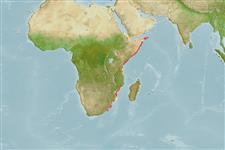Teleostei (teleosts) >
Eupercaria/misc (Various families in series Eupercaria) >
Labridae (Wrasses) > Cheilininae
Etymology: Cirrhilabrus: Latin, cirrus = curl fringe + Greek, labros = furious (Ref. 45335); africanus: Named for the continent of Africa; noun in apposition.
Environment: milieu / climate zone / depth range / distribution range
Ecology
Marine; reef-associated; depth range 18 - 50 m (Ref. 114940). Tropical
Distribution
Countries | FAO areas | Ecosystems | Occurrences | Point map | Introductions | Faunafri
Western Indian Ocean: Kenya and most probably in South Africa and Mozambique.
Size / Weight / Age
Maturity: Lm ? range ? - ? cm
Max length : 6.5 cm SL male/unsexed; (Ref. 114940); 4.4 cm SL (female)
Short description
Identification keys | Morphology | Morphometrics
Dorsal spines (total): 11; Dorsal soft rays (total): 9; Anal spines: 3; Anal soft rays: 9. This species is distinguished by the following characters: D XI,9; A III,9; pectoral-fin rays 15; pored lateral-line scales 15-18 + 6-7 (+1 over caudal-fin base); median predorsal scales 3-4; cheek with 5-7 scales in single row below the eye; uniserial row of suborbital pores; gill rakers 14-16. Morphometrics for terminal males: body depth 3.2-3.8 in SL; body width in depth 1.8-1.9; head length 3.0-3.1 in SL; the first 2 dorsal-fin spinous membranes moderately elongated and filamentous, 3.7-4.3 and 5.4-7.7 in SL, respectively; rounded caudal fin without extended upper and lower tips, 1.1-1.3 in HL; pelvic fins greatly elongated and broadly fan-like, reaching posteriorly to about middle of anal fin, 2.1-2.3 in SL; upper head and body reddish orange, lower head and body yellow to white, about three rows of small, well-spaced, bluish-to-lavender or reddish spots (not a stripe) across upper body; dorsal fin mostly dark to dusky red, divided mid-way out by a row of separated rounded spots (after first two membranes); caudal fin mostly dark with coppery-to-greenish sheen and numerous small pale spots and lines; the anal fin is mostly dark to dusky reddish; pelvic fins are greatly elongated and mostly dark to dusky reddish. (Ref. 114940).
Life cycle and mating behavior
Maturity | Reproduction | Spawning | Eggs | Fecundity | Larvae
Victor, B.C., 2016. Two new species in the spike-fin-fairy-wrasse species complex (Teleostei: Labridae: Cirrhilabrus) from the Indian Ocean. J. Ocean Sci. Found. 23:21-50. (Ref. 114940)
IUCN Red List Status (Ref. 130435: Version 2024-1)
Threat to humans
Harmless
Human uses
Fisheries: commercial; aquarium: commercial
Tools
Special reports
Download XML
Internet sources
Estimates based on models
Phylogenetic diversity index (Ref.
82804): PD
50 = 0.5000 [Uniqueness, from 0.5 = low to 2.0 = high].
Bayesian length-weight: a=0.01585 (0.00700 - 0.03587), b=2.95 (2.76 - 3.14), in cm total length, based on LWR estimates for this (Sub)family-body shape (Ref.
93245).
Trophic level (Ref.
69278): 3.3 ±0.4 se; based on size and trophs of closest relatives
Resilience (Ref.
120179): High, minimum population doubling time less than 15 months (Preliminary K or Fecundity.).
Fishing Vulnerability (Ref.
59153): Low vulnerability (10 of 100).
